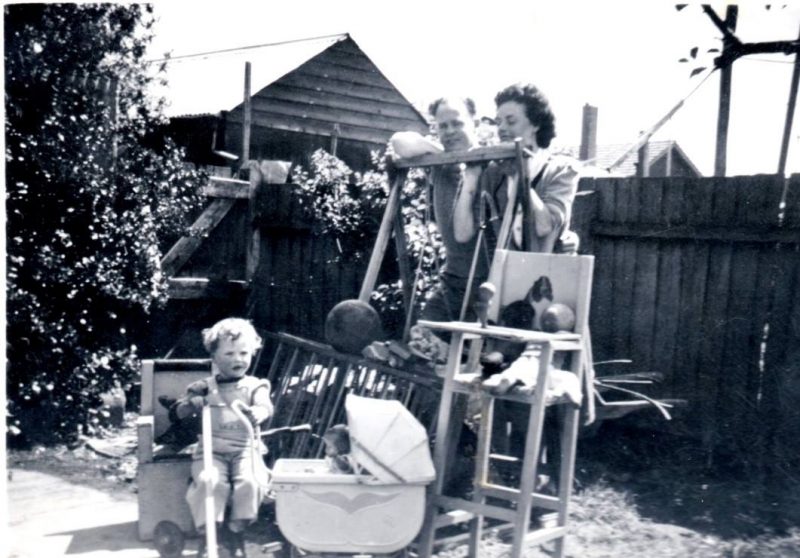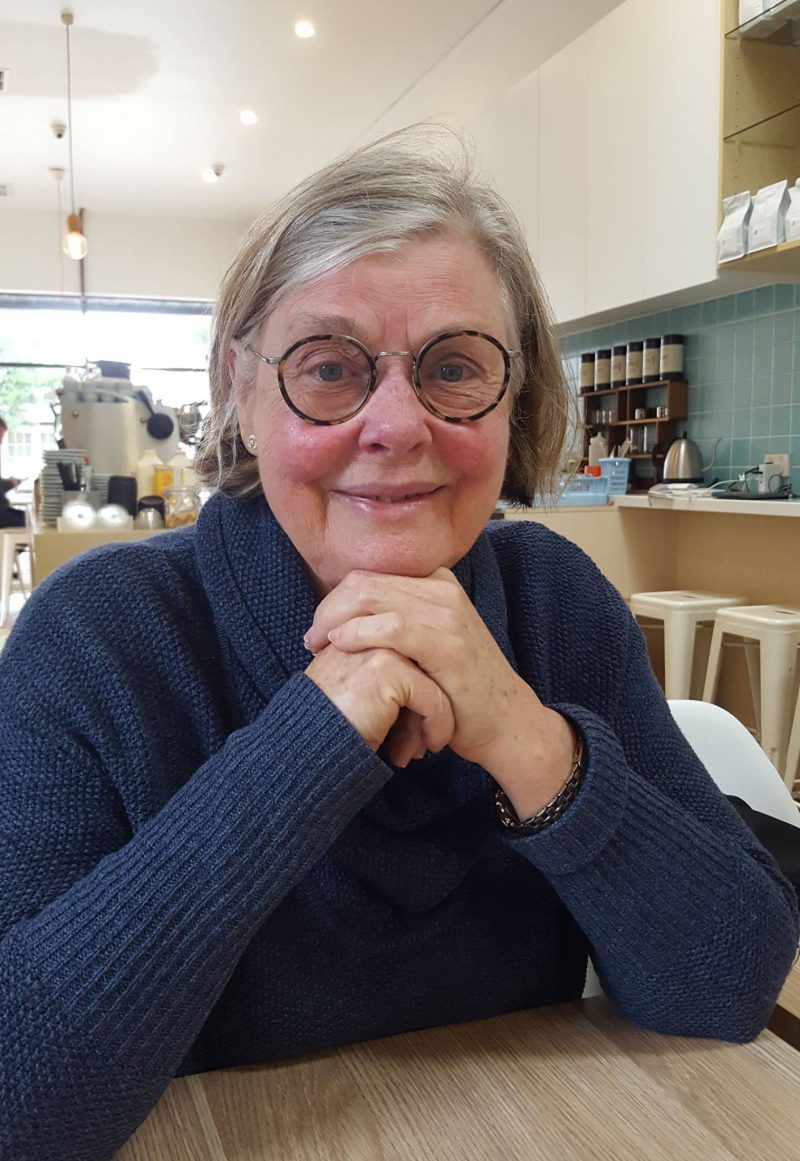Resident of Seddon
I’m the first of six children and was born in Mercy Hospital but came home to my grandparents’ home in Buxton Street, West Footscray. My Grandfather was Justin McCarthy, a footballer for Essendon Football Club and had participated in the Grand Final in both 1923 and 1924. For the first three years of my life, I lived with Justin and my Grandmother Hilma. The house still stands today.
Several years ago, the house was on the market and I pretended to be an interested buyer. Hilma used to have a beautiful fruit and vegetable garden which has been let go. I miss playing in the garden. The garage that Justin built, where he parked his Chevy in, is still there!
In the 1950s our family moved to Brighton. It had taken three years for the house to be built due to a shortage of building supplies. This was ju st after the war. In 1961 the entire family – it was eight of us by then – moved to Ormond. The house in Brighton was simply too small for eight people! The house in Ormond was a big old house, which suited us.
st after the war. In 1961 the entire family – it was eight of us by then – moved to Ormond. The house in Brighton was simply too small for eight people! The house in Ormond was a big old house, which suited us.
My dad’s name was John Patrick James Comerford Joseph O’Dea. We used to just go with ‘JPJCJ’, and letters would arrive addressed to him this way. When he was born he was dangerously ill, as was his mother, my aunt Fanny put all the names in, just in case he didn’t survive!
What’s funny was, I don’t have a second name. When I was born, I had the total attention of both sets of grandparents and families. At that time, none of them was married. When I left West Footscray at the age of three, they all told me there was a huge hole in the house.
I went to St Finbars Primary School in East Brighton, before moving to Star of the Sea, Lady’s College. I was so unladylike then. Australian writer Germaine Greer went there as well.
I remember the nuns were very progressive. They would always say ‘You can do whatever you want, don’t let them tell you anything else!’ It was a very feminist school. This was the 1960s, and it was good to have that challenge put there. We were always going ‘Really, can we?’
I muddled around after finishing high school. I did some Catholic teaching at the age of 17 and hated it as I had signed up for it thinking everybody had the same opportunity as I had. However, when I went out to teach, I realized I was very privileged compared to the students.
There were little boys who would wake up at 4am to work in the butcher shop and had to save money for shoes. A boy broke down when I told him he had to stay back after school. He couldn’t as he had to work. There was also a boy who had to visit his brother in jail. This was in East Hampton before it became affluent.
I said to my dad ‘these kids haven’t got a chance! They’re too busy making ends meet just to get by.’ Dad said ‘We can do the most we can, but we all get dealt a hand.’ I just couldn’t look at them in the eye, and I didn’t want to be there.
When I was 20, the family moved to Canberra. It’s different from a big city like Melbourne and I enjoyed my time there. I spent ten years there and married as well. My first three children – all girls – were born in Canberra.
In 1975, we moved back to Ormond in Melbourne. I was heavily pregnant then with my fourth child then, a boy. I have five children.
In the 1970s in Canberra, our education was free until university. The three older girls were very spoilt with the kind of options available. They had a state-of-the-art building, had all the choices available and were very protected. When they came to Melbourne, the school they were in, St Kevin’s Ormond, was just around the corner from home and they had to compete with ants and mice for lunch.
In those days, schools were classified into categories. St Kevin’s Ormond was categorized as ‘disadvantaged.’ The area was populated by pensioners and the parish was not interested in a small school that was used by very few students. The facilities were appalling and it was about the time when the government decided to give money to Catholic schools. But then young families started to come back into the area and before long we had a need for the school to be upgraded.
We did a lot of work to raise money and got involved to really change the school. All my five children went there, and I was involved in the special education programs.
I used to teach drama and softball in school. It was unpaid work but I enjoyed it. I had played competitive softball in Canberra and I was doing some theatre work in Ormond. One day, an agent came to one of our plays and said to me ‘You should have an agent and get some professional work.’ I was taken on and got involved in commercials, dramas and movies. I did a lot of theatre work and cabaret shows.
I got involved in local theatre because my husband Robert, thought I had become boring and suburban after I had our fourth child. He knew I loved theatre so he rang this local group and said, My wife has a lot of experience in Theatre would you have something for her to do? The group thought I must have had a lot of experience, but I had no experience other than being on the stage.
My first day as a Stage Manager, I had no idea what I was doing. I was sitting there enjoying the show and was yelled at to close the curtains. I learnt and found my space as I love being on the stage. It was my space. I owned it, and I am happy.
Life presents its challenges, and when Robert and I separated, that messed with my head. What also messed with my head was, when you’re doing and creating roles, you have to step into the thoughts, feelings, emotions and behaviours of the person you are portraying.
You have to take them on, laying down triggers in your body, mind and neuro pathways to connect with them. You rehearse until they become part of you. At the end of the run, you think you can let it go, but you can’t.
You pick up more as you move into another role, and at the end, I just couldn’t do it anymore. I knew I wasn’t myself and all my emotions were very close to the surface. I was in my mid-40s then; my mid-life crisis.
I realised there are a lot of actors and actresses who really struggled as they take on the emotions and feelings of someone else and it becomes them. You can’t just shake it off. You are changing who you really are as it surfaces at times when you don’t want it to.
It wasn’t until I started doing work on myself, I realized that actors who behave inappropriately were most likely retaining parts of previous roles and it’s become part of them.
By then I was doing theatre part time and was in charge of 33 sites across Australia as a Contract Manager. I was never at home, and only in Melbourne when work took me there. Between going in and out of Melbourne, I had purchased a house along Moore Street in West Footscray.
It used to be a drug dealer’s house, and I’d have people knocking at 2am. I would tell them ‘He’s not here anymore.’ They would hit up in the backyard and sleep in my shed. There would be caps and syringes everywhere but they would be gone when I got up in the morning.
In those days, if you drove down the laneways off Moore Street, there would be 50-60 bodies sleeping along those streets. Many knew my shed was covered, so when it rained it was full.
I didn’t know what to do with them. I couldn’t turn them away, but they weren’t doing me any harm. They never bothered or made contact with me. All they needed was a safe place to hit up. As a result, I couldn’t see any reason to stop them.
In 2005, I sold the house. It wasn’t due to the people in the back. Work was taking me up to Canberra and I was servicing the loans for four houses then. I just needed to sell them. And I did.
Ultimately, I bought in Seddon. When I purchased, I wanted to do something that was my own business as I didn’t want to retire and wanted something to do. I wanted something that interested me, and I felt like I was doing something that was useful.
 In the journey of learning hypnotherapy, when you work with people, you have to be clean. Otherwise, you will be triggered by their stories. And that could make you ineffective in being able to help them. I also felt it was a good idea to work with as many Hypnotherapists as possible so I could experience their styles and incorporate the best into my work.
In the journey of learning hypnotherapy, when you work with people, you have to be clean. Otherwise, you will be triggered by their stories. And that could make you ineffective in being able to help them. I also felt it was a good idea to work with as many Hypnotherapists as possible so I could experience their styles and incorporate the best into my work.
In doing the cleanup, I realize what had happened with the acting. It’s like if you play a victim role, ultimately that’s what you become. You will keep acting the same roles as you’re so good at it. You see how some actors or actresses are typecast and it’s hard to break that. I began to realise what had happened, so I wanted to get rid of emotions and feelings that were linked together.
People come to me for various reasons – quit smoking, anxiety or weight loss. I do all of that, but the focus of my work moving forward is going to be my new program, ‘Cleansing The Character.’
I have created it to help actors release the triggers, feelings and emotions they have created to be able to play a ‘role.’ Often they find that their personality ultimately becomes a mishmash of all the roles they have played and that emotionally they can become somewhat unstable. My program can help them release those learned behaviours and emotions.
I have 11 grandchildren who I adore and see reasonably regularly. I babysit quite a lot. I like the setup, as I find grandparenting absolutely fantastic and fascinating. It’s much more fun than parenting as there are no responsibilities and you can have fun. I don’t have to teach them anything as it’s not my responsibility. My responsibility is that they have a good time and that they are safe.
Some people would say you’d always come back to within 5km of where you were born. Sometimes I think to myself, ‘I’m finishing up in Brighton!’ However I wasn’t brought born there, and now I am within 5km of where I was born.
In seven decades, I’ve seen so much change here. There was a tip at the end of Buxton Street in West Footscray when we were children. We would slide down the sides of the tip on corrugated iron that had been deposited there as rubbish. My parents used to have a fit as it was dangerous, but no one had any great accidents. There were at least five beautiful picture theatres in Footscray and surround and they’re all turned into apartments. The tram used to go all the way up Barkly Street too, just past Sims Supermarket.
The people who used to live in Footscray were Italian immigrants. When more immigrants arrived, it changed to Vietnamese. Now it’s changed to African. Whatever the latest immigrant group is, it’s reflected in Footscray as it’s close to the city and still relatively affordable. Each new group set up market stalls and shops and the culture of the retail outlets in Footscray changes. Next door is Yarraville which is very different in that the shopping is very food focused and of course you have all the wonderful cafes and the picture theatre and the bookshops.
A lot of Seddon used to be Footscray back then. Where I live now would have been classified as Footscray back then. Life is so much faster now but it allows me to meet a lot of interesting business owners. I want to continue to study and re-educate myself so I’m better equipped for the future.
Leave a Comment
You must be logged in to post a comment.




I love this picture Roberta had sent to me for her nostalgic image. It’s a little Roberta with her parents in their old home in West Footscray. Treasured memories these are. 🙂
I live in Buxton st! Would love to know which house it was!
number 4
That is really interesting, loved reading your history.